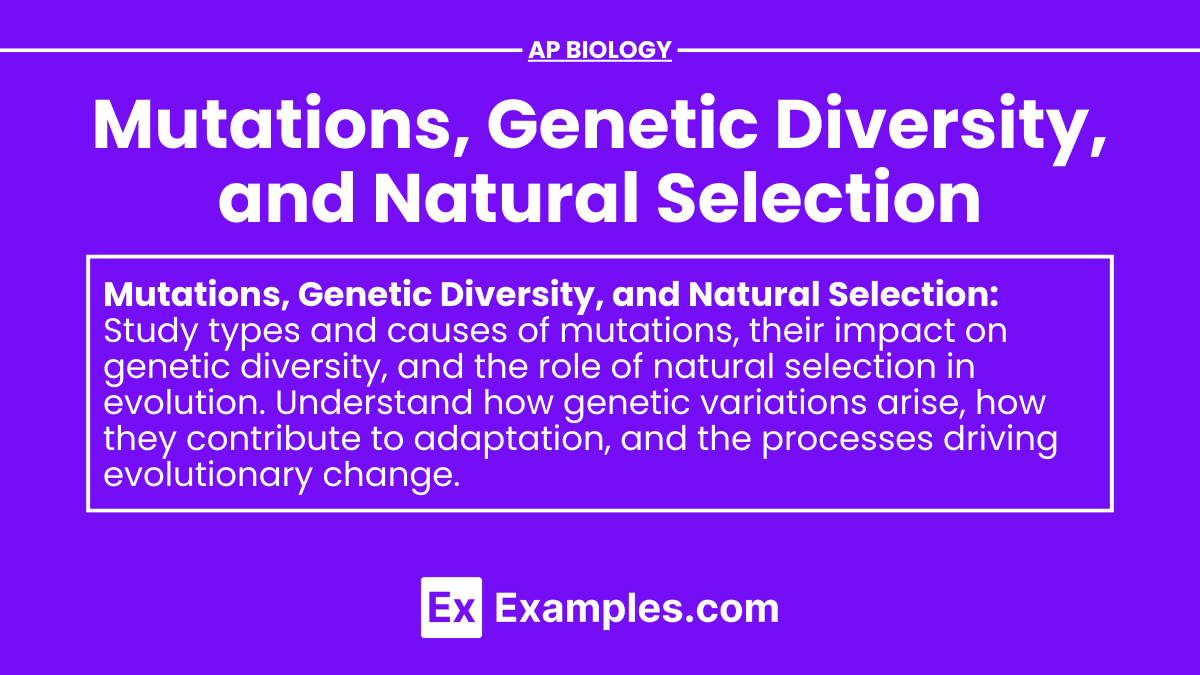In AP Biology, understanding how mutations contribute to genetic diversity and drive natural selection is essential. Changes in DNA can alter an organism’s genotype, leading to variations that enhance adaptation to the environment. For example, in plants, self-pollination can preserve beneficial mutations, promoting survival in stable conditions. These processes illustrate the dynamic interplay between genetics and evolution, shaping the diversity of life on Earth.
Learning Objectives
By studying mutations, genetic diversity, and natural selection, you will understand how mutations in nucleic acids (DNA and RNA) create genetic variations that lead to different phenotypes. You will explore how these genetic changes contribute to the diversity of traits within populations and how natural selection acts on these traits to drive evolution and adaptation. This knowledge will provide you with a foundation for understanding evolutionary biology and the mechanisms behind the diversity of life.
Mutations
Definition
- Mutations: Permanent changes in the DNA sequence of an organism’s genome.
Types of Mutations
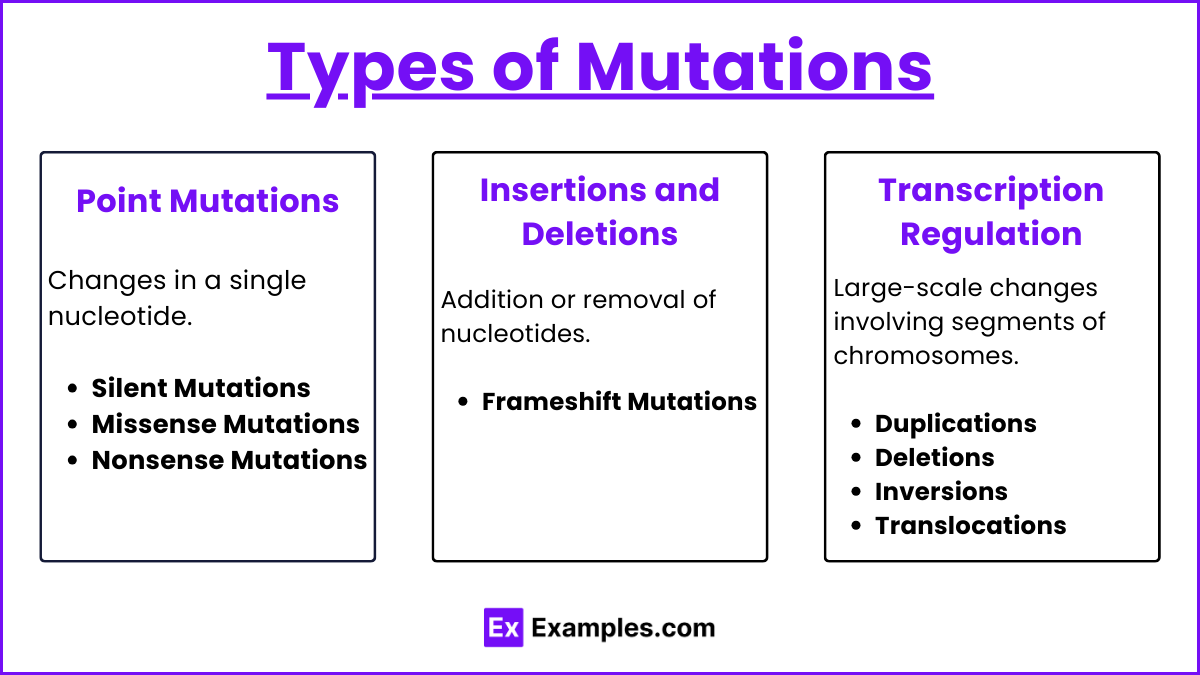
- Point Mutations: Changes in a single nucleotide.
- Silent Mutations: No change in the amino acid sequence of the protein.
- Missense Mutations: Change in a single amino acid in the protein.
- Nonsense Mutations: Introduction of a premature stop codon, leading to truncated proteins.
- Insertions and Deletions: Addition or removal of nucleotides.
- Frameshift Mutations: Insertions or deletions that alter the reading frame of the gene.
- Chromosomal Mutations: Large-scale changes involving segments of chromosomes.
- Duplications: Repeated segments of chromosomes.
- Deletions: Loss of chromosome segments.
- Inversions: Reversal of chromosome segments.
- Translocations: Rearrangement of segments between nonhomologous chromosomes.
Causes of Mutations
- Spontaneous Mutations: Occur without any external influence, often during DNA replication.
- Induced Mutations: Result from exposure to mutagens such as radiation, chemicals, or viruses.
Effects of Mutations
- Neutral Mutations: No significant effect on the organism.
- Beneficial Mutations: Provide an advantage in a specific environment.
- Harmful Mutations: Detrimental to the organism, possibly causing genetic disorders or reduced fitness.
Genetic Diversity
Definition
- Genetic Diversity: The total number of genetic characteristics in the genetic makeup of a species.
Sources of Genetic Diversity
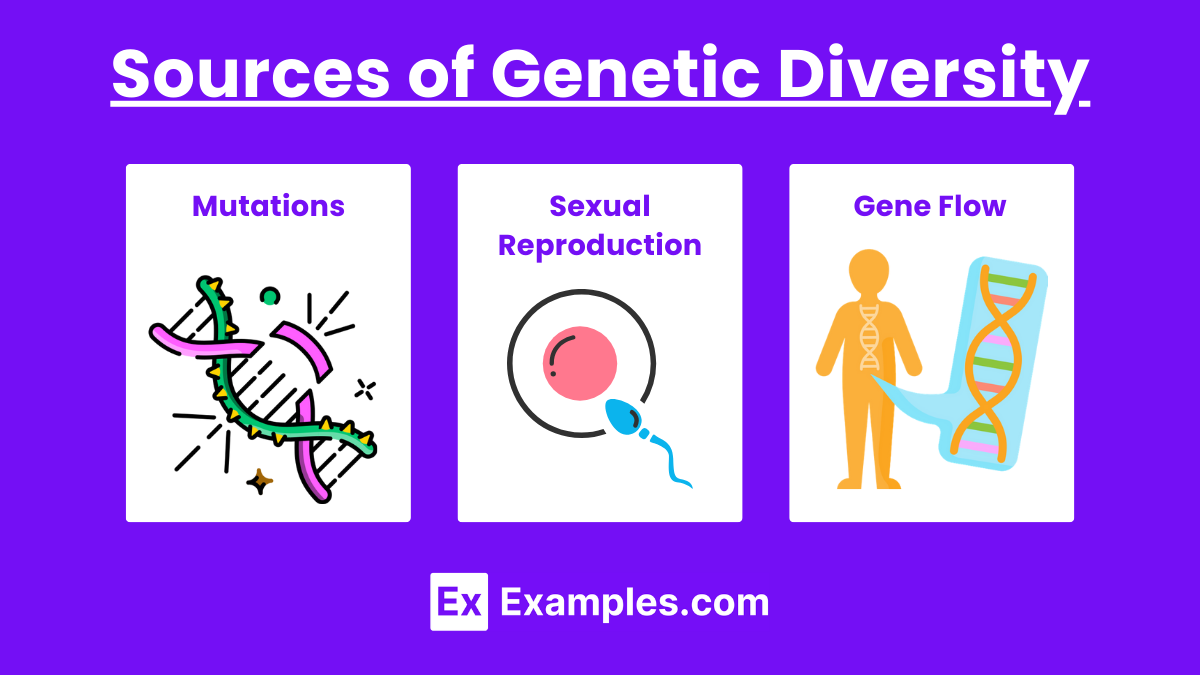
- Mutations: Introduce new genetic variations.
- Sexual Reproduction: Combines genetic material from two parents, producing unique offspring.
- Crossing Over: Exchange of genetic material between homologous chromosomes during meiosis.
- Independent Assortment: Random distribution of homologous chromosomes during meiosis.
- Random Fertilization: Random combination of gametes during fertilization.
- Gene Flow: Movement of genes between populations through migration and interbreeding.
Importance of Genetic Diversity
- Adaptation: Enables populations to adapt to changing environments.
- Survival: Reduces the risk of extinction by providing a broader range of traits that can withstand different conditions.
- Evolution: Fuels the process of natural selection and evolutionary change.
Natural Selection
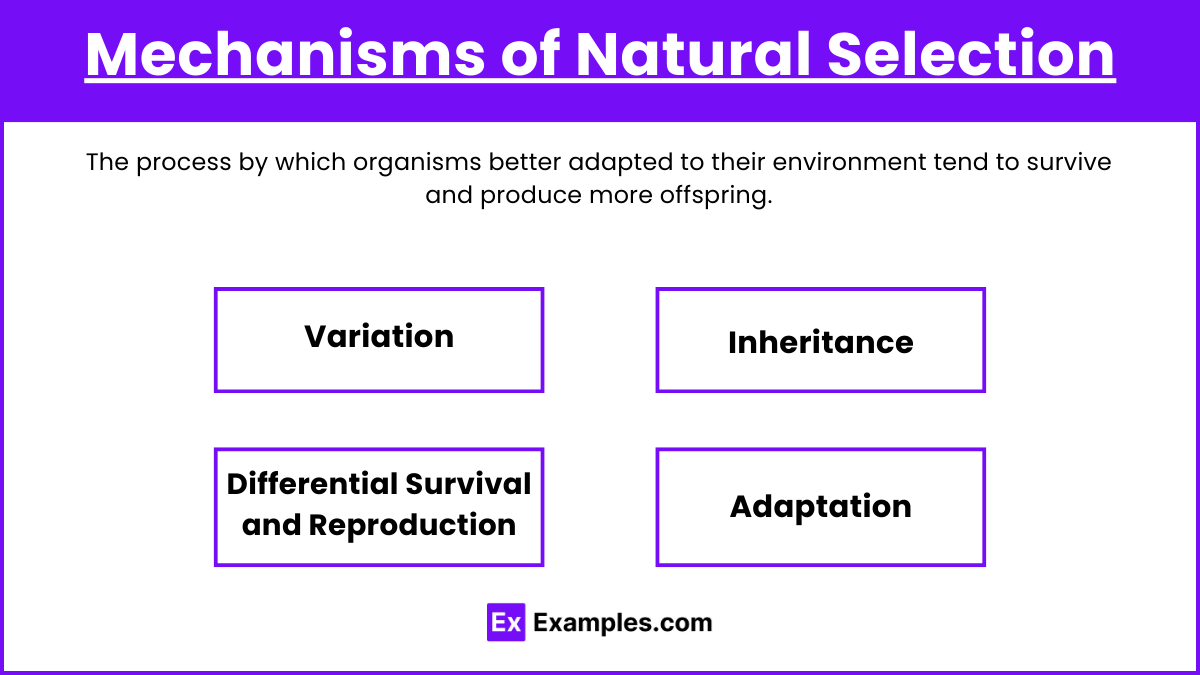
Definition
- Natural Selection: The process by which organisms better adapted to their environment tend to survive and produce more offspring.
Mechanisms of Natural Selection
- Variation: Differences in traits among individuals in a population.
- Inheritance: Traits must be heritable to be passed on to the next generation.
- Differential Survival and Reproduction: Individuals with advantageous traits are more likely to survive and reproduce.
- Adaptation: Over time, advantageous traits become more common in the population.
Types of Natural Selection
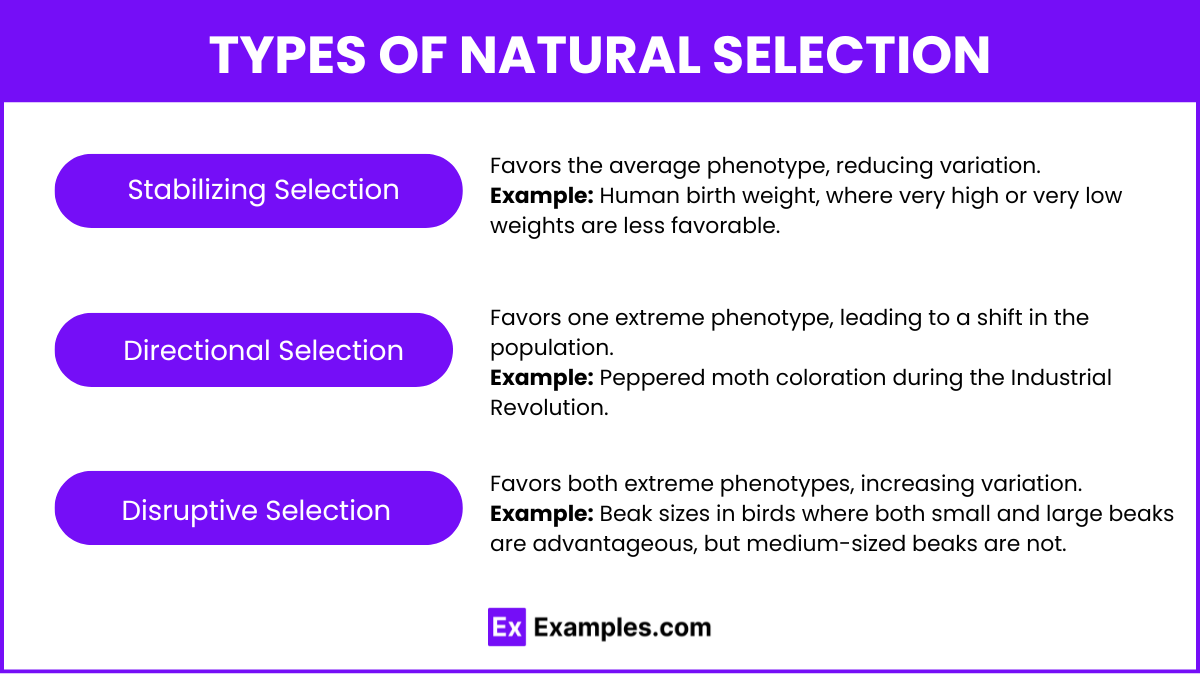
- Stabilizing Selection: Favors the average phenotype, reducing variation.
- Example: Human birth weight, where very high or very low weights are less favorable.
- Directional Selection: Favors one extreme phenotype, leading to a shift in the population.
- Example: Peppered moth coloration during the Industrial Revolution.
- Disruptive Selection: Favors both extreme phenotypes, increasing variation.
- Example: Beak sizes in birds where both small and large beaks are advantageous, but medium-sized beaks are not.
Effects of Natural Selection
- Adaptive Evolution: Evolution of traits that enhance survival and reproduction.
- Speciation: Formation of new species through the accumulation of genetic changes.
Interplay of Mutations, Genetic Diversity, and Natural Selection
Evolutionary Process
- Mutation: Introduces new genetic variants.
- Genetic Diversity: Provides a pool of traits for natural selection to act upon.
- Natural Selection: Filters these traits, favoring those that enhance survival and reproduction.
Examples
- Example 1: Sickle Cell Anemia
- Mutation: Point mutation in the hemoglobin gene.
- Genetic Diversity: Heterozygous individuals have a mix of normal and mutant hemoglobin.
- Natural Selection: Heterozygous advantage in malaria-endemic regions, providing resistance to malaria.
- Example 2: Antibiotic Resistance in Bacteria
- Mutation: Spontaneous mutation leading to antibiotic resistance.
- Genetic Diversity: Resistant bacteria survive antibiotic treatment.
- Natural Selection: Resistant bacteria reproduce, increasing the frequency of the resistance gene in the population.
- Example 3: Darwin’s Finches
- Genetic Diversity: Variations in beak size and shape.
- Natural Selection: Different beak types favored by different food sources, leading to adaptive radiation.
- Example 4: Industrial Melanism in Peppered Moths
- Genetic Diversity: Variations in coloration (light and dark morphs).
- Natural Selection: Dark morphs favored in polluted environments, light morphs favored in clean environments.
- Example 5: Lactose Tolerance in Humans
- Mutation: Mutation in the lactase gene allowing lactose digestion in adulthood.
- Genetic Diversity: Lactose tolerance varies among populations.
- Natural Selection: Lactose tolerance favored in populations with a history of dairy farming.
Practice Questions and Answers
Question 1
How do mutations contribute to genetic diversity?
A. By eliminating harmful traits from a population.
B. By introducing new genetic variations through altering DNA sequences.
C. By stabilizing existing traits in a population.
D. By reducing the overall genetic variability.
Answer: B. By introducing new genetic variations through altering DNA sequences.
Description: Mutations introduce new genetic variations by altering DNA sequences. These variations can result in new traits that may be beneficial, neutral, or harmful. For example, a point mutation in the hemoglobin gene leads to sickle cell anemia, creating genetic diversity in the population. Heterozygous individuals (carrying one mutated allele) have a survival advantage in malaria-endemic regions, demonstrating how mutations can contribute to genetic diversity and be subject to natural selection.
Question 2
Explain the role of natural selection in the evolution of antibiotic resistance in bacteria.
A. Natural selection eliminates all bacteria, both resistant and susceptible.
B. Natural selection increases the mutation rate in bacteria.
C. Natural selection favors bacteria with mutations that provide antibiotic resistance.
D. Natural selection decreases the reproduction rate of resistant bacteria.
Answer: C. Natural selection favors bacteria with mutations that provide antibiotic resistance.
Description: Natural selection plays a crucial role in the evolution of antibiotic resistance in bacteria. When a spontaneous mutation occurs that provides resistance to an antibiotic, those bacteria with the mutation survive the antibiotic treatment, while susceptible bacteria die off. The resistant bacteria reproduce and pass the resistance genes to their offspring. Over time, the frequency of the resistance gene increases in the bacterial population, illustrating natural selection’s role in adapting to environmental pressures.
Question 3
Describe an example of stabilizing selection and its impact on a population.
A. Stabilizing selection increases genetic variation by favoring extreme phenotypes.
B. Stabilizing selection reduces variation by favoring the average phenotype.
C. Stabilizing selection eliminates average phenotypes, increasing extremes.
D. Stabilizing selection has no impact on the phenotypic distribution.
Answer: B. Stabilizing selection reduces variation by favoring the average phenotype.
Description: Stabilizing selection favors the average phenotype and reduces variation within a population. An example is human birth weight. Infants with very low or very high birth weights have higher mortality rates, while those with average birth weights have higher survival rates. This selection pressure reduces the extremes in birth weight, resulting in a higher frequency of average-weight infants and maintaining a relatively stable birth weight distribution in the population.

